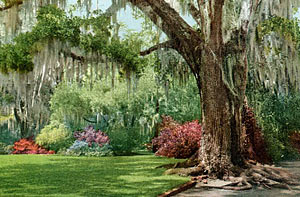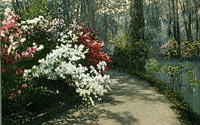
Magnolia Plantation and Gardens
Charleston, South Carolina
Camellia Collection Charleston, South Carolina

Courtesy Magnolia Plantation and Gardens
history continued
While local legend holds that Magnolia's first camellias were a gift from botanist Andre Micheaux circa 1790, research suggests that John Grimké Drayton planted the first Japanese Camellia plants at Magnolia in the 1830s. Drayton spent considerable time with his family in Philadelphia, Pennsylvania, a center of camellia cultivation during this time, which suggests the initial source of the Magnolia plantings. During the 1940s, he also imported camellias directly from England and Europe. By 1858, Drayton had over 120 cultivars of japonica in the gardens.
The camellia is native to Asia, where it is much revered. The first camellia, a single red, arrived in the United States from London, England, in 1797 at the Port of Philadelphia. At that time, camellias were grown solely in greenhouses, with Boston, New York, and especially Philadelphia as centers of this new horticulture. The camellias likely arrived in the South, especially in coastal South Carolina and Georgia, by the 1830s. The evergreen settled perfectly into the Southern climate with its short, relatively warm winters and long growing season.

Courtesy Magnolia Plantation and Gardens
Drayton’s successes with the Magnolia Camellia Collection were interrupted, though, when South Carolina became the first state to secede from the Union in December of 1860. The ensuing Civil War devastated much of the South, and the close involvement of Charleston and the nearby plantations along Ashley River Road meant that the region suffered greatly. Many of the plantations were burned or ravaged, including Magnolia. While, the plantation’s main house was destroyed, the gardens remained fairly intact.